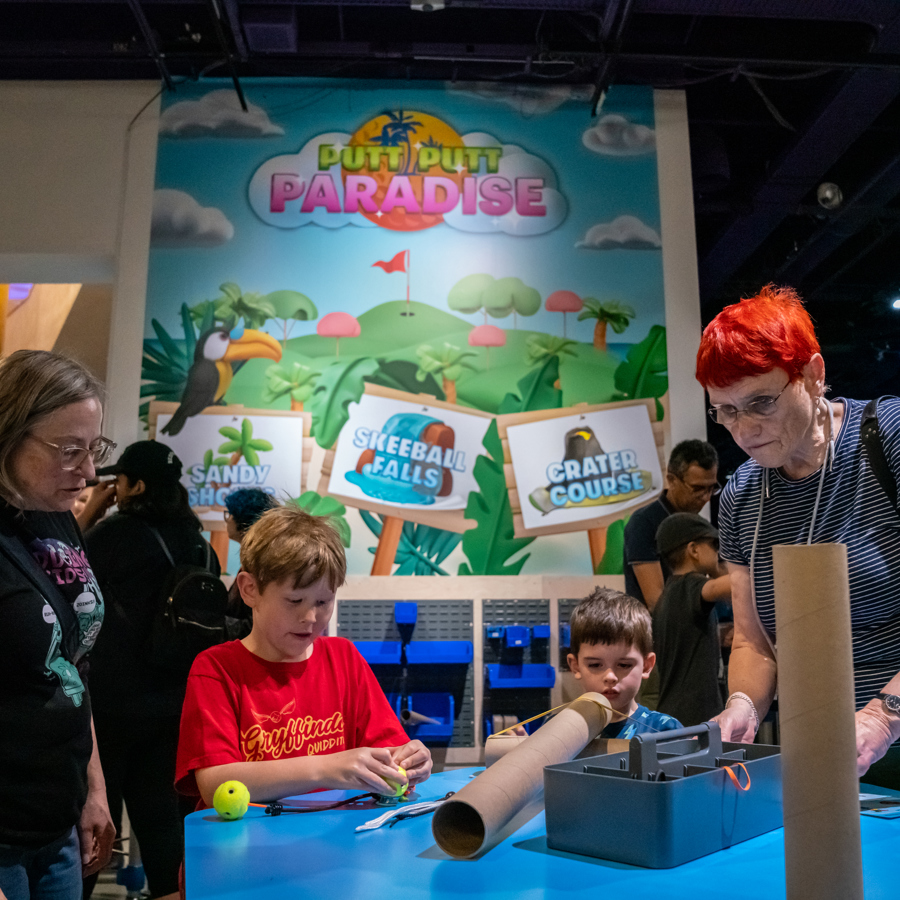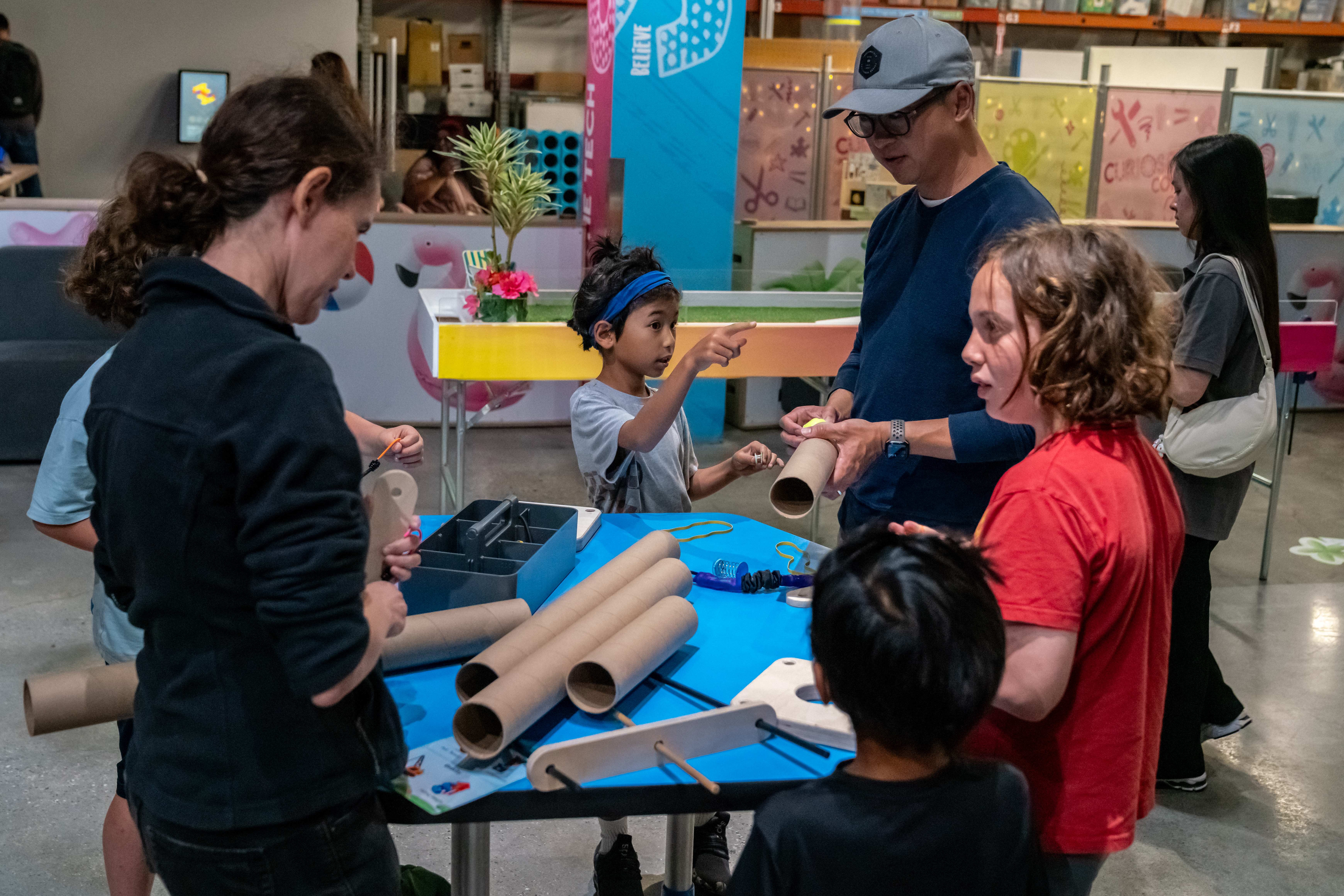
Kate Fischer Wants You to Engineer Your Own Luck in Putt Putt Paradise
September 12, 2025

- Related Topics:
- Education,
- Behind the Scenes,
- The Tech at Home,
- What's New at The Tech Interactive,
- Working at The Tech,
- Exhibits
Who is Kate Fischer?
Kate Fischer is the Senior Program Developer at The Tech Interactive. She holds a B.S. in Applied Physics with a background in electronics and an M.A. in Science Education. Her academic emphasis focused on informal learning spaces including summer camps and museums. In her current role at The Tech, she runs large scale exhibit spaces, lab content, and is an education collaborator for many internal content teams.
Have you ever wondered how an exhibit goes from idea to reality? We recently had the chance to sit down with Kate Fischer and learn all about the design iteration process behind The Tech Interactive’s newest exhibit, “Putt Putt Paradise.”
1. What was the initial inspiration for “Putt Putt Paradise”?
Kate: I went into our initial meetings wanting something around carnival games. I had this inspiration of finding a way to think about games of chance, like a carnival game throwing ping pong balls or rolling a bowling ball and trying to get it to stay in place. I had a vision, “what if we could turn games like this into an engineering based challenge?” So, it wasn’t about mini-golf at first. The big idea was “is it truly possible to engineer your own luck?”. I wanted to create something instead that was a game that people could come connect to and immediately understand.

2. How long did this project take from concept to creation?
Kate: The whole process takes the majority of the year. Around late fall, we start brainstorming with a bunch of people from different departments. We ask a few main questions: What are cool things we want visitors to do? What are cool science concepts we could talk about? What themes do we want to explore? Dozens of ideas came out of these sessions and it took until January to narrow it down. Then, I ask for prototypes from The Tech Shop. I try each of these prototype ideas with my team. Then, I refine these and we keep testing. At this point it’s already like 7 or 8 rounds of iteration to the activity. By early May things start to look more solid. I consult our graphics team and they start to bring the activity to life. They pitched me the name “Putt Putt Paradise” as a Barbie meets beach meets mini golf. I loved that and we ran with it for our signage. Lastly, we test with visitors on a small scale in Tech Studio. There we learn things like, “oh, the grass is too tall” or “the holes are too tiny” and the visitor feedback helps us make those critical detailed changes.

3. How do you decide what this activity looks for visitors vs. for staff?
Kate: We need two levels of content: one for the visitors, and a more in-depth guide for our staff. I work on this with my team, but some of the most valuable feedback comes from our Educator Advisory Committee. During the design process, I take our content to this group of local educators and share the topics and language I’m considering. They’re a huge help because they’d say, “Oh you used the words ‘push and pull’, that’s awesome. Those are in my second grade science standards”. Or a sixth-grade teacher would say “Can you also add the words ‘tension and compression’ to meet our standards too?”. Now I’ve got materials for staff to share language that meets the standards our local schools are also teaching. It’s a giant innovation design circle where I have to keep listening and processing feedback that I hear from people. Sometimes you have to make compromises but this is a process with truly everyone.

4. Does the design process truly ever end for an exhibit?
Kate: This process is going to keep going. We haven’t yet stress-tested this exhibit on a big scale. I’m looking forward to seeing how it handles large school groups. Our busiest days could have over 1,000 kids in the building. What does that look like for this exhibit? Some questions will become more logistical. For example, finding a way to have the science content visibly printed in the space for parents or chaperones to support connections in their own multi-generational groups. We’ve never done this before so I want to see how we make content that helps people feel empowered to read the info and amplify it.

5. What advice would you give to someone starting their own big project?
Kate: You are not an expert in everything, and you're not expected to be. At every stage of a project, there's a moment when you should stop working alone and ask for help from others. Whether it's a teammate, a mentor, or a family member, asking for advice and consulting with other people is a critical part of the process.

Takeaways
#1 Engineering is Everywhere: Kate’s project began by asking a simple question: “How can we take something that has luck, like mini-golf, and engineer our own luck?”. Innovative thinking is not just for complex problems, but also everyday challenges!
#2 Collaboration is Magic: Kate shared how she’s not an expert in everything. Her success came from consulting many diverse teams. Any project can be improved with different perspectives.
#3 Iteration Doesn’t Have to End: Innovation is a continuous cycle of observation, testing, and refinement. Even after this exhibit launched, Kate and her team continue to make adjustments based on how visitors interact with the space.
 Skip Navigation
Skip Navigation
